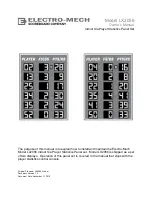
English
30
9. GLOSSARY
9.
GLOSSARY
Clock
With the analog input signal display, the analog signal is converted to a digital
signal by the LCD circuitry. To convert the signal correctly, the LCD monitor needs
to produce the same number clock pulse as the dot clock of the graphics system.
When the clock pulse is not correctly set, some vertical bars of distortion are
displayed on the screen.
Color Temperature (Temperature)
Color Temperature is a method to measure the white color tone, generally
indicated in degrees Kelvin. At high temperatures the white tone appears
somewhat blue, while at lower temperatures it appears somewhat red. Computer
monitors generally give best performance at high temperature settings.
6,500 K: Warm-white tone, similar to white paper or daylight.
9,300 K: Slightly bluish white.
Gain Adjustment
Adjusts each color parameter for red, green and blue. The color of the LCD
monitor is displayed through the color filter of the LCD panel. Red, green and blue
are the three primary colors. The colors on the monitor are displayed by
combining these three colors. The color tone can change by adjusting the
illumination amount passed through each color
’
fs filter.
Phase
The phase adjustment decides the sampling timing point for converting the analog
input signal to a digital signal. Adjusting the phase after the clock adjustment will
produce a clear screen.
Range Adjustment
The Range Adjustment controls the level of output signal range to display the
whole color gradation.
Resolution
The LCD panel consists of a fixed number of pixel elements which are illuminated
to form the screen image. The EIZO L551 display panel consists of 1280
horizontal pixels and 1024 vertical pixels. At a resolution of 1280 x 1024, all
pixels are displayed as a full screen.
Summary of Contents for FLEXSCAN L551 -
Page 1: ......










































